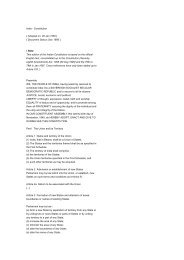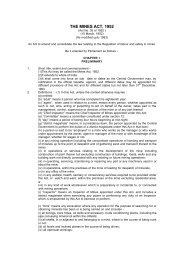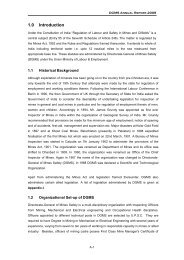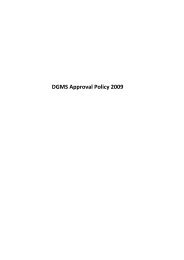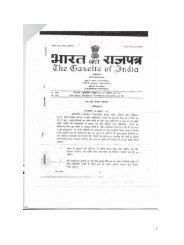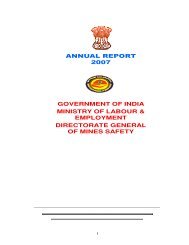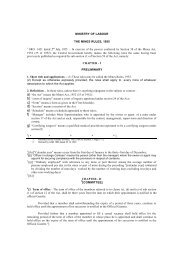Metalliferous Mines Regulations, 1961 - Directorate General of ...
Metalliferous Mines Regulations, 1961 - Directorate General of ...
Metalliferous Mines Regulations, 1961 - Directorate General of ...
You also want an ePaper? Increase the reach of your titles
YUMPU automatically turns print PDFs into web optimized ePapers that Google loves.
TABLE B<br />
NUMBER OF MAN-DAYS ETC.<br />
Give maximum number <strong>of</strong> persons employed on any one d ay during the quarter-<br />
(i) in workings belowground on ……………………….(a)……………………………<br />
(ii) in all in the mine on ………………………………..(a) ……………………………<br />
Number <strong>of</strong> working days during the quarter :<br />
Aggregate number <strong>of</strong> Aggregate number <strong>of</strong> man days lost on account <strong>of</strong> absence<br />
mandays workerd<br />
Below ground<br />
(i) Face<br />
Workers<br />
and<br />
Loaders<br />
(ii) Others<br />
Opencast Workings :<br />
(b) (c) (d) (e)<br />
Men Women sickness Accident Leave Other cause Total<br />
(i) Miners &<br />
Loaders<br />
(ii) Others(f)<br />
Above ground :<br />
Total<br />
If there is any marked increase or decrease in attendance or absence, please account for it.<br />
Signature <strong>of</strong> person<br />
Signing the return _____________<br />
INSTRUCTIONS<br />
(a) Give day <strong>of</strong> the week and the date and month.<br />
(b) The information should cove all persons “Employed” in the mine as defined in clause(h) <strong>of</strong> section 3<br />
<strong>of</strong> the <strong>Mines</strong> Act, 1952, including clerical and subordinate supervisory staff.<br />
(c) Total number <strong>of</strong> man-days worked should be obtained by adding the daily attendance for the whole<br />
quarter<br />
(d) Total number <strong>of</strong> man-days lost by absence should be obtained by adding the daily absences for the<br />
whole quarter.<br />
(e) Absences should include all cases in which a person is “scheduled to work” or is expected to turn up<br />
for work, but does not. All permanent employees are to be treated as “Schedule” to work. So far as<br />
temporary or casual employees are concentrated a person who attended work during the preceding<br />
week should be considered as scheduled to work during the week under consideration unless :<br />
(i) He has reported his intention to quit, or<br />
(ii) His services have been terminated by the management, or<br />
(iii) He does not turn up for work during the whole week.





